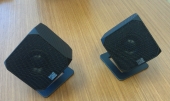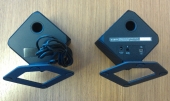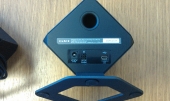 |
Initial impressions:
 |
Out of the box, each cube speaker felt solid in the hand. Often is the case when you hold a speaker in your hand it feels hollow, this isn’t one of those cases. The matte, almost rubberized texture of the speaker cabinet really added to the stylish and modern motif that Palo Alto is after with these Cubik speakers. The speaker grill sort of blends into the dimpled speaker cabinet, but allows for the 2.5” driver to be easily seen at the same time (I am a big fan of having visible drivers, but that preference will vary from person to person). The Palo Alto badging doesn’t seem to detract from the overall aesthetics. The matte metal stands share the same cube shape and feel extremely weighted and sturdy, which should give these speakers a solid and stable foundation. Lastly, the included user manual was more like a pamphlet, but then again there isn’t a lot going on with these speakers from a setup perspective.
Setup, Function, and Sound:
For setup I did reference the included user manual, but this is one of those products that you can probably forego given its straight forward nature. The metal stands are the first to install, and only fit one way. Joined together by a large screw and a lock washer, the speaker and stand mate extremely well together forming a very solid union. Next up are all the various wire attachments. One of the Cubik speakers has all the required inputs (power, USB, and left speaker). It is here I first noted the lack of an auxiliary source jack. An auxiliary source jack has almost become common place, and the absence definitely surprised me. I know these are USB audio streaming speakers, but given that these are higher end speakers, it would have been nice to have the ability to plug in an MP3 player for example. Moving on with the setup, I attached the left speaker, USB, and power to the right speaker. All that remained was plugging the USB cable into my computer. My windows 7 test system discovered the Palo Alto Cubik speakers automatically and with no intervention on my part, the Cubik speakers came to life.
 |
 |
Now that the speakers were functional it was time to evaluate the controls. There are four buttons on the right speaker that allow you to adjust bass on/off, mute on/off, volume up, and volume down. All of which are extremely self explanatory, easy to operate and I found them to be well placed for easy intuitive access. Aside from these controls, any audio management needs to be manipulated via the source. I would have liked to have seen some form of accompanying audio management application, to allow for some fine control over the sound, but I suspect that Palo Alto has engineered these speakers to be relatively, if not completely sonically tuned out of the box. This leads us to my subjective review of the Cubik’s sound quality.
 |
In a word, I would summarize the overall sound experience as “crisp”. I know that word is thrown around a lot when reading (or writing) speaker reviews, and as such has lost its significance a bit. However, that is literally the first thing that sprang to mind as I listened to a few audio tracks. The clarity at which various instruments can be heard was extremely notable, and generally as I ramped the volume…there were only a few occasions I noted any distortion whatsoever. The sound stage was very impressive and I could move from side to side and there was little change in the overall sound. Now, I am a fan of deep bass, as I prefer a deep rich sound while I listen to some “pop” music. So it was here that I tested the Bass button on the right speaker. Enabling and disabling the Bass on the Cubik speakers was noticeable, but in some cases was too subtle for my taste, and conversely gave some audio tracks a hollow bass sound. So I found myself toggling the Bass initially for testing purposes, but eventually for overall sound enjoyment reasons. Simply put, having the extra bass enabled helped and sometimes it just really didn’t. However, before anyone reads that as a negative, bare in mind I tested a wide variety of music genres and so depending on yours, you may not have the need to continually manipulate the bass setting. I think the only real negative to the sound was that overall it just didn’t have enough bass to give me the full sound I prefer. It’s here where tastes will differ from person to person, and it’s here where this won’t be a negative for everyone.

[…] and Headsets: — Palo Alto Cubik 2.0 — CM Storm Sirius […]
[…] Palo Alto Cubik 2.0 Speaker Review @ TechwareLabs […]
[…] Palo Alto Cubik 2.0 Speaker Review @ TechwareLabs […]
[…] Palo Alto Cubik 2.0 Speaker Review @ TechwareLabs […]
[…] Palo Alto Cubik 2.0 Speaker Review @ TechwareLabs […]